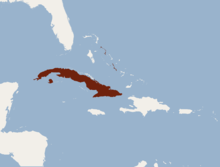Gervais's funnel-eared bat
Gervais's funnel-eared bat (Nyctiellus lepidus) is a species of bat in the family Natalidae. It is monotypic within the genus Nyctiellus.[2] It is found in Bahamas and Cuba.
| Gervais's funnel-eared bat | |
|---|---|
 | |
| Scientific classification | |
| Kingdom: | Animalia |
| Phylum: | Chordata |
| Class: | Mammalia |
| Order: | Chiroptera |
| Family: | Natalidae |
| Genus: | Nyctiellus Gervais, 1855 |
| Species: | N. lepidus |
| Binomial name | |
| Nyctiellus lepidus Gervais, 1837 | |
 | |
| Synonyms | |
|
Natalus lepidus (Gervais, 1837) | |
Sources
- Davalos, L.; Mancina, C. (2016). "Nyctiellus lepidus". The IUCN Red List of Threatened Species. 2016: e.T14358A22040604. doi:10.2305/IUCN.UK.2016-3.RLTS.T14358A22040604.en.
- Simmons, Nancy B. (2005), "Chiroptera", in Wilson, Don E.; Reeder, DeeAnn M. (eds.), Mammal Species of the World: A Taxonomic and Geographic Reference (3rd ed), Baltimore: Johns Hopkins University Press, pp. 312–529, ISBN 978-0-8018-8221-0, retrieved 12 September 2009
gollark: It already supports arbitrary JS.
gollark: Shades of blue are too important to be left to chance, heavpoot.
gollark: * purposes (sorry, phone)
gollark: For Minoteaur purposed.
gollark: Oh. That reminds me, working on useful features is boring, so I need people to suggest slightly insane features instead.
This article is issued from Wikipedia. The text is licensed under Creative Commons - Attribution - Sharealike. Additional terms may apply for the media files.
